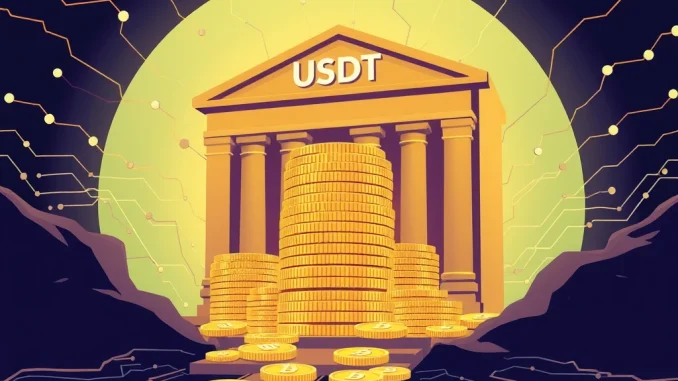
Hey crypto enthusiasts! Get ready for a significant update straight from the stablecoin world. A massive amount of USDT has just been added to the ecosystem. According to reports from Whale Alert, a staggering 1 billion USDT minted at the Tether Treasury. This event is more than just a number; it has potential implications for the broader crypto market and is certainly making waves in the latest stablecoin news.
What Exactly Happened? A Look at the Tether Mint
So, what exactly happened? The blockchain tracking service, Whale Alert, flagged a transaction indicating that Tether, the issuer of the world’s largest stablecoin, USDT, created 1,000,000,000 new USDT tokens. This operation occurred directly at the Tether Treasury, which acts as Tether’s reserve wallet and distribution hub.
Minting, in the context of stablecoins like USDT, means creating new tokens. Unlike mining cryptocurrencies like Bitcoin, stablecoins are typically ‘minted’ by the issuing company (Tether, in this case) when users or large institutions deposit fiat currency (like US dollars) or other approved assets into Tether’s reserves. This process is supposed to maintain the 1:1 peg between USDT and the US dollar.
Key details of the event:
- Amount: 1,000,000,000 USDT (which is 1 billion USDT)
- Location: Tether Treasury
- Reported by: Whale Alert
- Action: Minting (creation of new tokens)
This isn’t the first time Tether has minted a large sum, but 1 billion USDT is a substantial figure that warrants attention.
Why Does Tether Mint So Much USDT?
The primary reason Tether mints new USDT is in response to market demand. When large players, such as institutional investors, exchanges, or over-the-counter (OTC) desks, need a large amount of USDT, they typically go directly to Tether. They deposit fiat currency or other assets, and in return, Tether issues (mints) the equivalent amount of USDT.
Potential drivers for a large Tether mint like this include:
- Increased Demand: Growing interest in using USDT for trading on exchanges, facilitating cross-border payments, or holding value within the crypto ecosystem.
- Institutional Inflow: Large institutions entering the crypto space often use stablecoins as a gateway or for managing liquidity.
- Reserve Management: Tether might be adjusting its reserves or preparing for anticipated demand from specific partners.
- Market Making: Providing liquidity on various platforms.
Essentially, a large mint often signals that there is significant demand for USDT in the market, indicating potential capital inflows into the crypto space.
What Could 1 Billion USDT Mean for the Market?
The minting of 1 billion USDT can have several potential implications for the cryptocurrency market:
Increased Liquidity: More USDT available means more capital is ready to be deployed. This freshly minted stablecoin can be sent to exchanges, making it easier for traders to buy other cryptocurrencies like Bitcoin or Ethereum.
Potential for Price Movement: While USDT itself is designed to stay pegged to the dollar, a large influx of USDT can increase buying pressure on other crypto assets if the minted tokens are used to purchase them. This doesn’t guarantee a market pump, but it adds potential fuel for upward price action.
Market Sentiment: Large mints are sometimes interpreted by traders as a bullish signal, suggesting that significant capital is entering or preparing to enter the market. This perception alone can influence trading behavior.
Focus on Stablecoins: Events like this highlight the growing importance and scale of stablecoins in the crypto economy. They act as crucial bridges between traditional finance and decentralized markets.
It’s important to note that the minting itself doesn’t automatically inject this capital into specific assets. The minted USDT sits in the Tether Treasury wallet initially and is then distributed to exchanges, institutions, or other large clients based on their purchases.
Understanding the Tether Treasury
The Tether Treasury is a key component of Tether’s infrastructure. It’s the digital wallet address (or addresses) controlled by Tether where newly minted USDT is held before being released into circulation. It also receives USDT when tokens are redeemed (burned) for fiat currency. Tracking activity from the Treasury wallet provides insights into the supply dynamics of USDT.
Beyond the Mint: Considerations
While a large Tether mint can be seen as a sign of demand, it also brings back discussions around Tether’s reserves and transparency. Critics often raise questions about whether every USDT token is truly backed 1:1 by equivalent assets. Tether has made efforts to provide attestations and reports on their reserves, but scrutiny remains a constant factor.
This event is a reminder that while stablecoins offer stability and utility, understanding their underlying mechanisms and the operations of issuers like Tether is crucial for anyone involved in the crypto market.
Actionable Insight
For market observers, tracking large stablecoin movements, especially from the Tether Treasury, can provide clues about potential market liquidity and sentiment shifts. It’s one data point among many to consider when analyzing market conditions.
Compelling Summary
The recent minting of 1 billion USDT minted at the Tether Treasury is a significant event underscoring the continued high demand for the world’s largest stablecoin. This fresh supply of USDT could inject substantial liquidity into the crypto market, potentially influencing asset prices and market sentiment. While the exact impact will unfold as the tokens move from the Treasury, this large-scale Tether mint is a clear indicator of activity and interest within the crypto ecosystem, making it a key piece of current stablecoin news.



